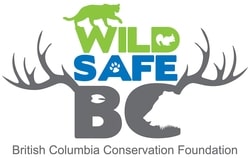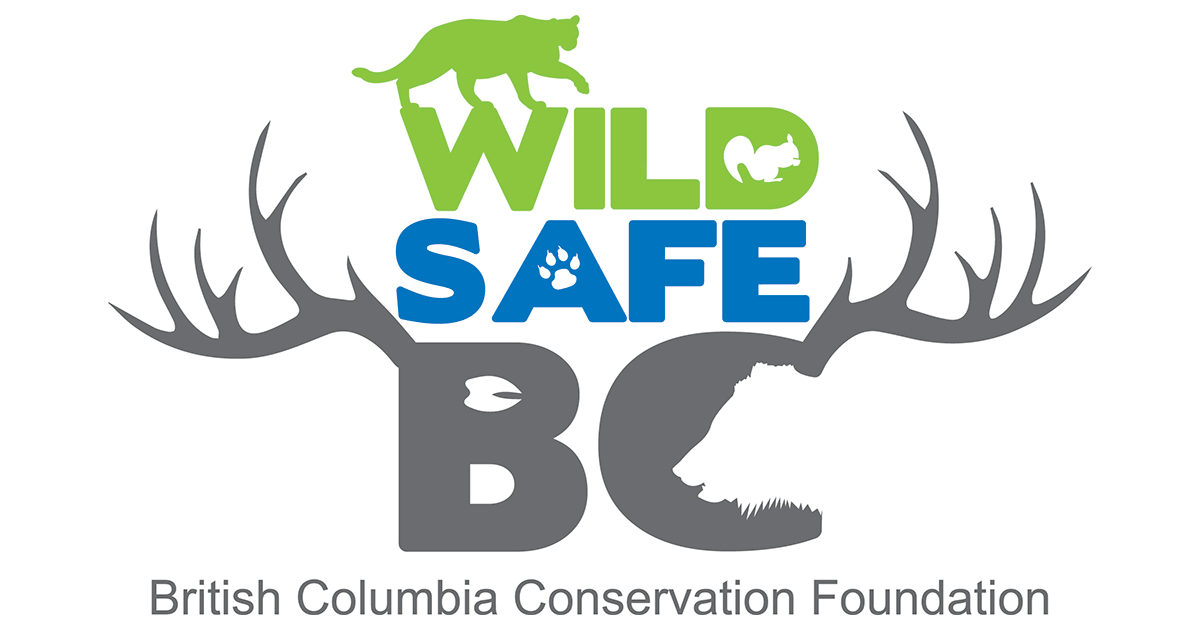Moose
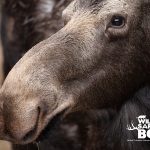 Moose Snapshot
Moose Snapshot
Moose (Alces americanus) are the largest members of the deer family Cervidae as well as the tallest land mammals in North America. Moose can be found throughout most of BC except for coastal areas. Moose are not normally aggressive and tend to avoid urban areas, however they will perceive dogs as threats and females are protective of their calves. They may also be attracted to people’s gardens. As moose are large animals, vehicle-moose collisions are the biggest threat to human safety. Moose are responsible for over 600 calls to the Conservation Officer Service every year, with the majority of the reports coming from the northern half of the province. Moose continue to be an important species for rural communities and Indigenous Peoples of BC.
If you are experiencing conflict with moose, call the Conservation Officer Service at 1-877-952-7277.
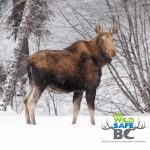 Wild Moose Facts
Wild Moose Facts
- Only male moose (bulls) grow antlers. Their antlers can reach up 1.8 m in spread
- Cow moose can emit an audible moan during breeding season that can be heard up to 3 km away
- Newborn calves can stand on their own feet on the day they are born
- Moose are strong swimmers that can submerge themselves completely to feed on aquatic plants
Identification
Adult male moose (bulls) can weigh between 400 to 600 kilograms and grow to a height of over two meters at the shoulder. Females (cows) tend to be smaller, ranging in weight from 300 to 500 kilograms. Moose are distinguished from others in the deer family by their size, dark brown coat, prominent shoulder hump, bulbous nose and a characteristic flap of skin called a “bell” or “dewlap” below the chin. Male moose grow massive palmate (palm-shaped) antlers. These antlers can grow to a width of 1.8 meters. There are three subspecies of moose in BC with the smallest in the southeastern part of the province and the largest residing in the north.
Biology
Cow moose give birth to one calf and occasionally two between May and June. In years when food is plentiful, the rate of twins increases. Moose calves mature quickly and can reach a weight of 100 kilograms in six months.
Moose are herbivores and feed on a wide variety of vegetation in the summer including the twigs and leaves of red-osier dogwood, willow, cottonwood, fir and paper birch. Woody shrubs and aquatic plants are also important summer foods. In winter, when food is restricted to mostly twigs and bark, moose may lose up to one quarter of their body weight. Moose pack on extra weight in the fall to survive this annual loss.
Moose are surprisingly strong swimmers and can even submerge themselves completely to feed on aquatic plants. Long legs and large cloven hooves help moose to travel through deep snow and soft mud. They are well-adapted to living in cold environments with their long guard hairs and undercoat. Moose have keen senses of hearing and smell.
Bull moose begin to grow their antlers in late April or early May. These antlers are bone-like structures that grow from a stubby protrusion called a pedicle. While they grow, the antlers are covered in velvet which provides the nourishment necessary for continued antler growth. Velvet is shed at the end of summer or early fall. The antlers are shed every year between late December and early January. The older bulls shed their antlers first and some yearlings may still have antlers into Match.
Moose may live up to 20 years in the wild, but the average lifespan ranges between 10-15 years. Moose can be weakened by winter ticks and other parasites resulting in malnutrition. Moose commonly die from predation, starvation, hunting or vehicle and rail collisions. Severe winters that make travel difficult and reduce food availability can make them more susceptible to predation by wolves and grizzly bears. Black bears may predate on young calves and moose have also been killed by cougars.
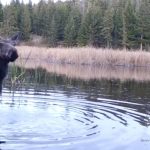 Behaviour
Behaviour
Bulls use their antlers both for display and fighting in order to assert dominance and to secure breeding privileges with the cows. Normally solitary, bulls and cows come together during the breeding season or “rut” between September and October. Both sexes become vocal during this time as they actively seek a mate. Female moose may be aggressive with one another and they select their mate rather than the other way around. Moose may also ‘yard-up’ in groups during times of deep snow and benefit from the group effect of the snow being trampled down. They may also congregate in small groups around mineral licks.
Range and Habitat
Moose are most abundant in the central and northern Interior and the boreal forests of BC. This includes northern BC, Cariboo-Chilcotin, Thompson-Okanagan and Kootenay regions. Occasionally they will follow river valley bottoms to tidewater but they are generally absent from the coast and the dry southern Interior. Moose will travel between spring, summer, fall and winter ranges that average 5 to 10 sq km in size. In winter they will travel to wetlands along valley bottoms where they can find sufficient browse and will eat up to 20 kg of food.
Moose Safety
Never approach a moose. Give the animals a wide berth and ensure they always have an escape route. Moose cows are very protective of their young and may attack if they perceive a threat. If you come across a cow and calf, calmly leave the area immediately. Moose will perceive dogs as a threat and may seriously injure or kill a dog. Never let a dog loose in your yard to chase a moose as it may be injured or cause stress to the animal.
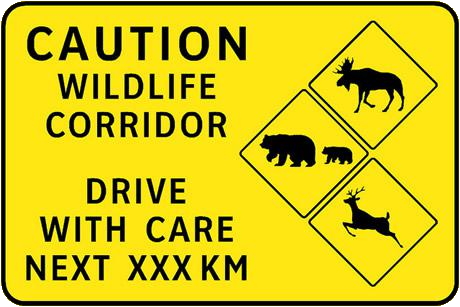
Be aware of moose body language. A threatened moose may lower its head and flatten its ears before charging. Avoid eye contact, back away slowly and speak softly. Meanwhile, find an escape route and scan the vicinity for a large object to place between you and the moose. While bear spray may be effective, there is little data to confirm this.
If a moose does charge you, put a large tree or other object between you and the animal. If there is a building or car nearby, get inside before the moose can reach you.
Every year, people die or are injured in vehicle-wildlife collisions. Use caution, especially at dawn, dusk and and at night when moose may be attracted to mineral licks or vegetation along roadsides. In BC, most vehicle collisions with moose occur in January and February and occur at night. Be extra vigilant in wildlife collision hotspots indicated by wildlife warning road signs. Learn more at wildlifecollisions.ca.
Conflict Reduction with Moose
In winter, when food is restricted to mostly twigs and bark, moose may lose up to one quarter of their body weight. In these times of scarce natural food, moose may move into urban settings to feed on backyard vegetation. Due to their sheer size and strength, moose can be dangerous and must always be given a wide berth. Never let your dog loose to chase off a moose.
Here are some tips for reducing conflict with moose:
- Do not feed moose or other wildlife. Feeding moose in urban settings can lead to more conflicts and vehicle collisions
- Certain plants are more likely to attract moose (red-osier dogwood, red maple, willows). If moose frequent your neighbourhood, consider choosing less attractive plants when landscaping
- Use motion activated lights and sprinklers
- Use physical and/or electric fencing to exclude moose from your yard
- Encircle trees and shrubs with chicken wire to protect them from damage
- Clear thick brush that reduce sightlines and provide security cover and shelter to moose
- Ensure that hay and livestock feed is inaccessible to moose by using fencing and proper storage
For more information on protecting your garden or farm read WildSafeBC’s suggestions on how to reduce conflict where we grow.
Moose Resources
- BC Ecosystem Explorer
- Wildlife Collision Prevention Program
- Moose. Province of British Columbia.
- Living with Wildlife in BC: Ungulates. Advice for agriculture and rural land owners.
- Chronic Wasting Disease. Province of British Columbia
 Moose Snapshot
Moose Snapshot
Moose (Alces americanus) are the largest members of the deer family Cervidae as well as the tallest land mammals in North America. Moose can be found throughout most of BC except for coastal areas. Moose are not normally aggressive and tend to avoid urban areas, however they will perceive dogs as threats and females are protective of their calves. They may also be attracted to people’s gardens. As moose are large animals, vehicle-moose collisions are the biggest threat to human safety. Moose are responsible for over 600 calls to the Conservation Officer Service every year, with the majority of the reports coming from the northern half of the province. Moose continue to be an important species for rural communities and Indigenous Peoples of BC.
If you are experiencing conflict with moose, call the Conservation Officer Service at 1-877-952-7277.
 Wild Moose Facts
Wild Moose Facts
- Only male moose (bulls) grow antlers. Their antlers can reach up 1.8 m in spread
- Cow moose can emit an audible moan during breeding season that can be heard up to 3 km away
- Newborn calves can stand on their own feet on the day they are born
- Moose are strong swimmers that can submerge themselves completely to feed on aquatic plants
Identification
Adult male moose (bulls) can weigh between 400 to 600 kilograms and grow to a height of over two meters at the shoulder. Females (cows) tend to be smaller, ranging in weight from 300 to 500 kilograms. Moose are distinguished from others in the deer family by their size, dark brown coat, prominent shoulder hump, bulbous nose and a characteristic flap of skin called a “bell” or “dewlap” below the chin. Male moose grow massive palmate (palm-shaped) antlers. These antlers can grow to a width of 1.8 meters. There are three subspecies of moose in BC with the smallest in the southeastern part of the province and the largest residing in the north.
Biology
Cow moose give birth to one calf and occasionally two between May and June. In years when food is plentiful, the rate of twins increases. Moose calves mature quickly and can reach a weight of 100 kilograms in six months.
Moose are herbivores and feed on a wide variety of vegetation in the summer including the twigs and leaves of red-osier dogwood, willow, cottonwood, fir and paper birch. Woody shrubs and aquatic plants are also important summer foods. In winter, when food is restricted to mostly twigs and bark, moose may lose up to one quarter of their body weight. Moose pack on extra weight in the fall to survive this annual loss.
Moose are surprisingly strong swimmers and can even submerge themselves completely to feed on aquatic plants. Long legs and large cloven hooves help moose to travel through deep snow and soft mud. They are well-adapted to living in cold environments with their long guard hairs and undercoat. Moose have keen senses of hearing and smell.
Bull moose begin to grow their antlers in late April or early May. These antlers are bone-like structures that grow from a stubby protrusion called a pedicle. While they grow, the antlers are covered in velvet which provides the nourishment necessary for continued antler growth. Velvet is shed at the end of summer or early fall. The antlers are shed every year between late December and early January. The older bulls shed their antlers first and some yearlings may still have antlers into Match.
Moose may live up to 20 years in the wild, but the average lifespan ranges between 10-15 years. Moose can be weakened by winter ticks and other parasites resulting in malnutrition. Moose commonly die from predation, starvation, hunting or vehicle and rail collisions. Severe winters that make travel difficult and reduce food availability can make them more susceptible to predation by wolves and grizzly bears. Black bears may predate on young calves and moose have also been killed by cougars.
 Behaviour
Behaviour
Bulls use their antlers both for display and fighting in order to assert dominance and to secure breeding privileges with the cows. Normally solitary, bulls and cows come together during the breeding season or “rut” between September and October. Both sexes become vocal during this time as they actively seek a mate. Female moose may be aggressive with one another and they select their mate rather than the other way around. Moose may also ‘yard-up’ in groups during times of deep snow and benefit from the group effect of the snow being trampled down. They may also congregate in small groups around mineral licks.
Range and Habitat
Moose are most abundant in the central and northern Interior and the boreal forests of BC. This includes northern BC, Cariboo-Chilcotin, Thompson-Okanagan and Kootenay regions. Occasionally they will follow river valley bottoms to tidewater but they are generally absent from the coast and the dry southern Interior. Moose will travel between spring, summer, fall and winter ranges that average 5 to 10 sq km in size. In winter they will travel to wetlands along valley bottoms where they can find sufficient browse and will eat up to 20 kg of food.
Moose Safety
Never approach a moose. Give the animals a wide berth and ensure they always have an escape route. Moose cows are very protective of their young and may attack if they perceive a threat. If you come across a cow and calf, calmly leave the area immediately. Moose will perceive dogs as a threat and may seriously injure or kill a dog. Never let a dog loose in your yard to chase a moose as it may be injured or cause stress to the animal.

Be aware of moose body language. A threatened moose may lower its head and flatten its ears before charging. Avoid eye contact, back away slowly and speak softly. Meanwhile, find an escape route and scan the vicinity for a large object to place between you and the moose. While bear spray may be effective, there is little data to confirm this.
If a moose does charge you, put a large tree or other object between you and the animal. If there is a building or car nearby, get inside before the moose can reach you.
Every year, people die or are injured in vehicle-wildlife collisions. Use caution, especially at dawn, dusk and and at night when moose may be attracted to mineral licks or vegetation along roadsides. In BC, most vehicle collisions with moose occur in January and February and occur at night. Be extra vigilant in wildlife collision hotspots indicated by wildlife warning road signs. Learn more at wildlifecollisions.ca.
Conflict Reduction with Moose
In winter, when food is restricted to mostly twigs and bark, moose may lose up to one quarter of their body weight. In these times of scarce natural food, moose may move into urban settings to feed on backyard vegetation. Due to their sheer size and strength, moose can be dangerous and must always be given a wide berth. Never let your dog loose to chase off a moose.
Here are some tips for reducing conflict with moose:
- Do not feed moose or other wildlife. Feeding moose in urban settings can lead to more conflicts and vehicle collisions
- Certain plants are more likely to attract moose (red-osier dogwood, red maple, willows). If moose frequent your neighbourhood, consider choosing less attractive plants when landscaping
- Use motion activated lights and sprinklers
- Use physical and/or electric fencing to exclude moose from your yard
- Encircle trees and shrubs with chicken wire to protect them from damage
- Clear thick brush that reduce sightlines and provide security cover and shelter to moose
- Ensure that hay and livestock feed is inaccessible to moose by using fencing and proper storage
For more information on protecting your garden or farm read WildSafeBC’s suggestions on how to reduce conflict where we grow.
Moose Resources
- BC Ecosystem Explorer
- Wildlife Collision Prevention Program
- Moose. Province of British Columbia.
- Living with Wildlife in BC: Ungulates. Advice for agriculture and rural land owners.
- Chronic Wasting Disease. Province of British Columbia
